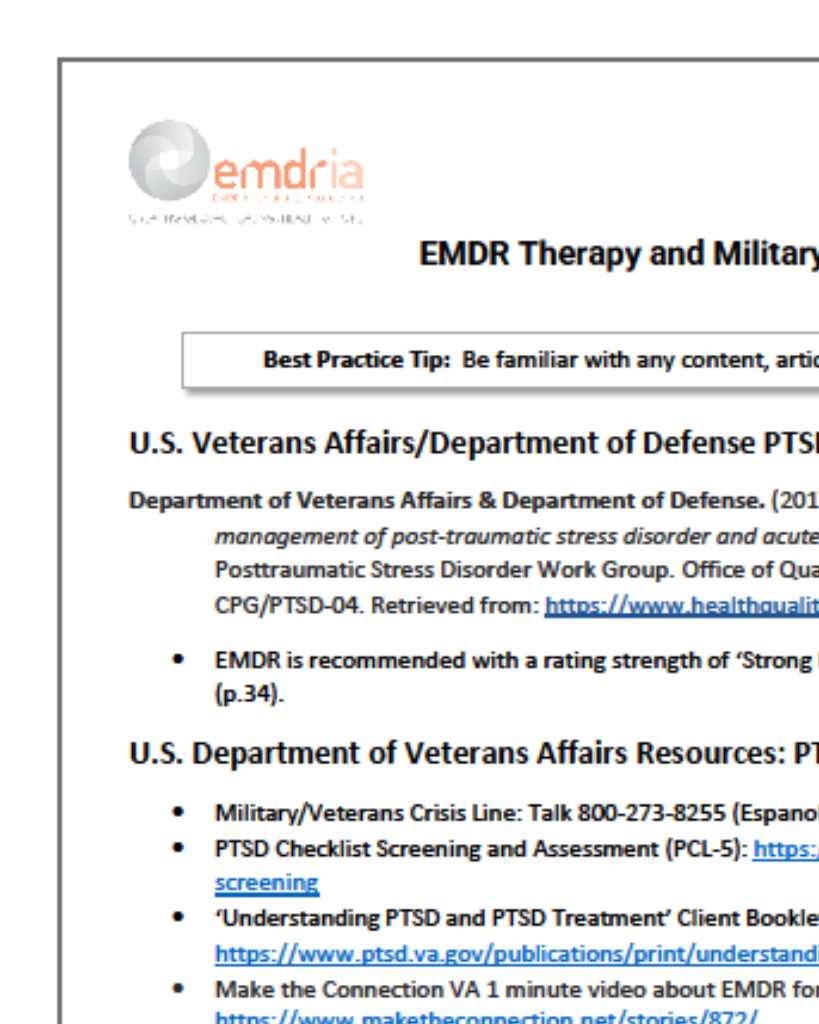Imagery rescripting (ImRs) and eye movement desensitization and reprocessing (EMDR) as treatment of childhood-trauma related post-traumatic stress disorder (Ch-PTSD) in adults: Effects on schema modes
This study evaluated the effects of imagery rescripting and EMDR therapy for adult patients with childhood trauma related PTSD.
Article Abstract
“Background: Many patients with post-traumatic stress disorder (PTSD) due to childhood trauma (Ch-PTSD) also suffer from comorbid personality pathology. Little is known about the effectiveness of treatments for Ch-PTSD in reducing the comorbid personality pathology. Schema Modes are an operationalization of personality pathology according to schema therapy and can be measured with the Schema Mode Inventory (SMI). Therefore, we evaluated the effects of two treatments for adult patients with Ch-PTSD on Schema Modes.
Method: Participants (n = 114) of the Imagery Rescripting and Eye Movement Desensitization and Reprocessing (IREM) Randomized Clinical Trial (Boterhoven de Haan, K. L., Lee, C. W., Fassbinder, E., Voncken, M. J., Meewisse, M., Van Es, S. M., Menninga, S., Kousemaker, M., & Arntz, A. (2017). Imagery rescripting and eye movement desensitization and reprocessing for treatment of adults with childhood trauma-related post-traumatic stress disorder: IREM study design. BMC Psychiatry, 17(1), 1–12, Boterhoven de Haan, K. L., Lee, C. W., Fassbinder, E., van Es, S. M., Menninga, S., Meewisse, M.-L., Rijkeboer, M., Kousemaker, M., & Arntz, A. (2020). Imagery rescripting and eye movement desensitization and reprocessing as treatment for adults with post-traumatic stress disorder from childhood trauma: Randomised clinical trial. The British Journal of Psychiatry, 217(5), 609–615) with Ch-PTSD who filled in the SMI next to other outcomes, were randomly allocated to a 12-session treatment of Imagery Rescripting (ImRs) or Eye Movement Desensitization and Reprocessing (EMDR). The SMI was collected at waitlist, pre-treatment, mid-treatment, posttreatment, and 8-week and 1-year follow-up.
Results: For both treatments, patients reported large reductions in the Maladaptive Schema Modes and improvements in the Adaptive Schema Modes (Cohen’s d = .94–1.18) from pre-treatment to posttreatment, 8-week follow-up, and 1-year follow-up. No statistically significant differences were found between ImRs and EMDR regarding changes in Schema Modes over time. No significant changes were observed during the waitlist period.
Conclusions: ImRs and EMDR showed improvements in Schema Modes when primarily targeting Ch-PTSD. The results indicate the possible value of both treatments in reducing comorbid personality pathology.”
—Description from publisher
Article Access
Open Access
Daniëls, M., Meewisse, M-L., Nugter, A., Rameckers, S. A., Fassbinder, E., & Arntz, A. (2025). Imagery rescripting (ImRs) and eye movement desensitization and reprocessing (EMDR) as treatment of childhood-trauma related post-traumatic stress disorder (Ch-PTSD) in adults: Effects on schema modes. European Journal of Psychotraumatology, 16(1): 2454191. Open access: https://doi.org/10.1080/20008066.2025.2454191
Date
February 7, 2025
Creator(s)
Martine Daniëls, Marie-Louise Meewisse, Annet Nugter
Contributor(s)
Sophie A. Rameckers, Eva Fassbinder, Arnoud Arntz
Topics
Childhood Trauma, PTSD
Extent
13 pages
Publisher
Informa UK Limited trading as Taylor & Francis Group
Rights
© 2025 The Author(s).
APA Citation
Daniëls, M., Meewisse, M-L., Nugter, A., Rameckers, S. A., Fassbinder, E., & Arntz, A. (2025). Imagery rescripting (ImRs) and eye movement desensitization and reprocessing (EMDR) as treatment of childhood-trauma related post-traumatic stress disorder (Ch-PTSD) in adults: Effects on schema modes. European Journal of Psychotraumatology, 16(1): 2454191. Open access: https://doi.org/10.1080/20008066.2025.2454191
Audience
EMDR Therapists, Other Mental Health Professionals
Language
English
Content Type
Article, Peer-Reviewed, RCT
Access Type
External Resource, Open Access




